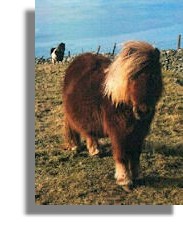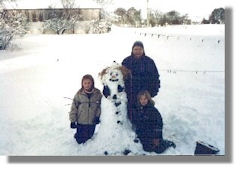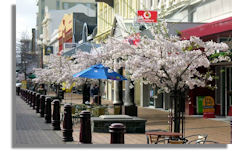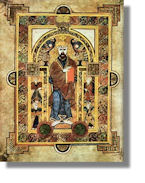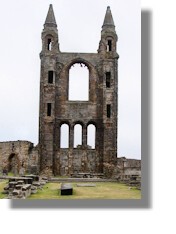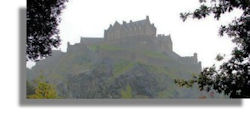The Scottish Snippets Newsletter in its original format began in April 1997 and continued in an unbroken series for 591 issues. Although no longer produced in that style, there is now this regular update on the new and updated pages on the Rampant Scotland site including "Scottie's Photo Diary From Scotland".
To receive a text version of this newsletter as a reminder to look at these Web pages when they are published, just send an e-mail to Scottie@RampantScotland.com with "Subscribe Newsletter" in the subject line.
Scotland's "Marie Celeste"
The sailing ship "Marie Celeste" became famous for having been discovered on 5 December 1872 in the Atlantic Ocean, unmanned and apparently abandoned (the one lifeboat was missing, along with its crew of seven). There was a similar incident on the Flannan Isles Lighthouse when all three keepers disappeared on December 13, 1900, just over a year after the light began operating, and were never heard of again. The event captured the imagination of the public in much the same way as the "Mary Celeste". The official Northern Lighthouse Board position is that a large body of water washed them out to sea. But, no one knows for sure the true story. The graphic on the right graphic is by Charles Tait. See: Scotland's "Marie Celeste".
Skerryvore Lighthouse
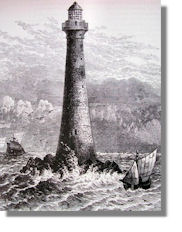
Skerryvore is a remote reef that lies off the west coast of Scotland, 12 miles (19 kilometres) south-west of the island of Tiree. Between 1790 and 1844 more than thirty ships were known to have been wrecked in the area. Sir Walter Scott was with a party of Northern Lighthouse Board Commissioners who visited the reef in 1814 and wrote vividly about the location. The lighthouse on the skerry was built with some difficulty between 1838 and 1844 by Alan Stevenson. See: Skerryvore Lighthouse
Shetland Ponies
Sharma writes about her delight at seeing the delightful, wild Shetland Ponies in their own environment on the most northerly islands of Scotland. See: Shetland Ponies
Snow Comes to Speyside
Blizzards, ice, sleet and more snow and fog on a journey combine to disrupt travel arrangements on a visit to Scotland in the winter. See the words and pictures: Snow Comes to Speyside
ENABLE Scotland Celebrates its 60th Anniversary
2014 is going to be a huge year for Scotland. Homecoming Scotland 2014 will reinforce Scotland's position on the international stage as a dynamic and creative nation. It will extend the benefits and opportunities offered by the Commonwealth Games and Ryder Cup in the year that "Scotland welcomes the world". It's also an important year because ENABLE Scotland marks its 60th anniversary. Originally set up in 1954 by parents ENABLE Scotland has helped people with learning disabilities and their families fight for a normal life for six decades. ENABLE Scotland provides much needed and innovative support in every part of the country - through early intervention, family based respite, supported living, education schemes, work experience and support for employers. They help people every step of the way including through difficult times of transition. At ENABLE Scotland they get things done. But in an increasingly hard public funding climate, they need investment from the private sector to do more, to work with more children, young people and families under great personal and financial pressure. As an individual or as part of an organisation, they would welcome any financial support via an event you may already have in your calendar this year. If you think you may be able to help, please contact linsey.forrester@enable.org.uk and for more information, please check their website www.enable.org.uk See also Links to Enabling Web Sites in Scotland.
Scottish Place Names in Invercargill, New Zealand
Ian Kendall has been working on the place names to be found in Invercargill, a town at the southern end of New Zealand's south island. Of the names of the 53 suburbs and semi-rural localities in the Invercargill area that have been identified to date, 21 (39.6%) can be found, in whole or in part, in Scotland or are based on Scottish family names. Of course, some of the names are used in other parts of the British Isles as well, but at least 12 of them (22.6%), including the name Invercargill itself, appear to have a definite Scottish association. Ian has also included a list of Invercargill street names with Scottish connections and, combined with the suburbs and localities they show that Invercargill appears to be one of the most 'Scottish' of towns and cities outside Scotland. The illustration of Invercargill is via Wikimedia. See: Scottish Place Names in Invercargill, New Zealand
Kings, Holy Men and a 'National' Church
Initially, the first duties of holy men were as the magicians and clerks of kings rather than acting as their conscience. The graphic here is from the "Book of Kells" via Wikimedia See: Kings, Holy Men and a 'National' Church
Kings, Holy Men and a 'National' Church (Part 2)
A papal bull of 1174 acknowledged the status of a national 'Scottish Church' as a 'special daughter' of Rome. The graphic shows the Ruin of St Andrews Cathedral. See: Kings, Holy Men and a 'National' Church (Part 2)
The Flight of the Salt and Pepper Shaker Birds
Toby Speed tells the fantasy love story of the salt and pepper shaker birds. See: The Flight of the Salt and Pepper Shaker Birds
Extreme Climatic Conditions
Frank Hatton writes about coping with extreme weather conditions in the UK and elsewhere, with particular emphasis on "pea soupers". The graphic shows Edinburgh Castle in the Mist. See: Extreme Climatic Conditions.Next Newsletter
The next newsletter is scheduled for 3 May.
Yours aye
Scottie
Previous editions of this Newsletter are available in an Archive. The Index to the other pages of the Rampant Scotland site is available here.
Where else would you like to go in Scotland?

